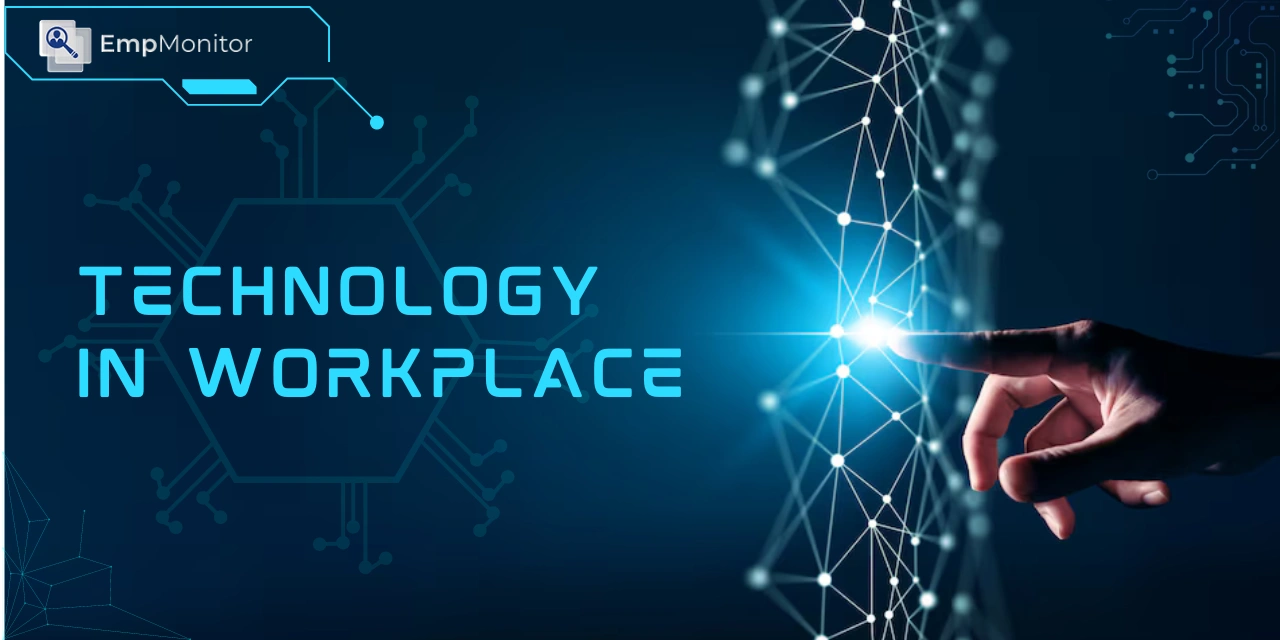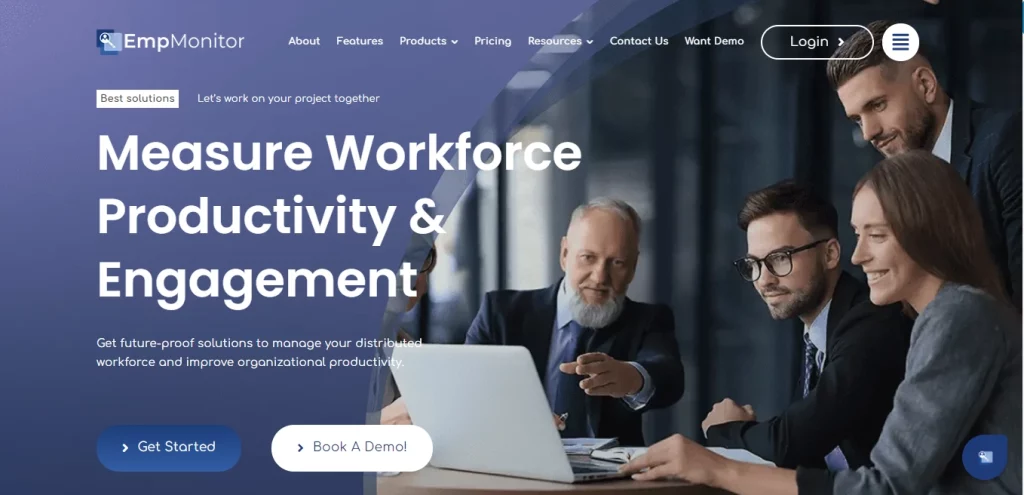As we move further into the 21st century, technology in the workplace is becoming increasingly integrated, reshaping how we work. The days of being restricted to one’s workstation are long gone, as we now carry computers, tablets, and mobiles at all times.
There are some downsides to relying heavily on technology in business, such as becoming dependent on it, the need for frequent upgrades, and the potential strain on workplace relationships. But, its benefits far outweigh these drawbacks when we integrate it into the workplace
Businesses must integrate technology seamlessly into their work environments to keep pace with these evolving trends. It ensures they stay competitive and aligned with the changing landscape of technology-driven workplaces.
There are plenty of advantages to having technology integrated into the workplace. Let’s understand why business owners are eager to stay updated with the latest IT trends and have strategies ready to adopt innovative tech solutions.
In a hurry? Listen to the blog instead!
Benefits Of Technology In The Workplace
Technology in the workplace is incredibly vital nowadays, as it’s fundamental to the success of any modern organization. Let’s explore some of the benefits it brings to the workplace.
Enhance Your Business’s Competitiveness:
If your company isn’t leveraging contemporary technological solutions, it’s probably lagging compared to your rivals. However, it’s never too late to start embracing digital transformation and make your business more focused on technology and more competitive.
Customers today expect quick responses and solutions, often through social media and live chat channels. This is why it’s important to incorporate technology in the workplace, like AI and automation, to provide efficient customer support. When customers are satisfied, they’re more likely to keep doing business with you and may even recommend you to others, boosting your profits.
Ensure Compliance With Regulations:
Aside from boosting productivity and efficiency, technology can also aid in achieving and adhering to compliance standards. Compliance is crucial, considering the numerous regulatory requirements. Technology use policy for employees is indispensable for businesses to meet these obligations.
Specific software and tools can help teams manage and secure vast amounts of sensitive data within an organization and across external systems. Automation in compliance processes can streamline tasks like documentation collection, audits, and scheduling reviews.
By leveraging technology in the workplace, businesses can identify compliance risks and stay current with evolving regulations more effectively.
Improved Efficiency:
Utilization of various business technology tools can boost productivity and efficiency by encouraging innovation and creativity. With the latest technology in the workplace, you can empower employees and improve work performance with the assistance of tech to deliver better results, foster healthy competition, and give your company a competitive advantage.
Technology also increases flexibility in terms of where work is required. By ensuring that content is accessible across various technological platforms, companies enable seamless collaboration among employees using smartphones, laptops, or tablets, ultimately saving time on tasks. Introducing technology into the workplace also allows employees to use their own devices.
Let us now learn about the essential technologies required in the workplace.
Key Impact Of Technologies In The Workplace:
Here are some workplace technologies that are fundamental for most organizations. Some have been around for a while and have stopped evolving, while others are newer and require careful planning to integrate throughout the organization.
Managing Documents Efficiently:
The volume of data produced daily is increasing rapidly. Your organization might generate immense documents, spreadsheets, forms, and videos daily, covering employee information, business operations, customer data, and marketing materials. Workers may work together across different kinds of data, and sophisticated search functions provide access to any file within the company.
Cloud-based document management systems are often the best solution for handling this data. Besides organizing data, they can also serve as learning platforms for employees, allowing them to access information in a structured way. Advanced search features make locating any file within the organization easy, and employees can collaborate seamlessly across various data.
Modern document management systems have evolved to include analytics capabilities for analyzing structured data.
Managing Tasks And Projects Efficiently:
Organizations must automate processes to maintain agility, saving time and resources by standardizing procedures. Automation technology in the workplace should offer flexible workflow design with controlled visibility.
Workflow tools should create user-driven workflows for departmental needs. Customizable project management tools handle ad hoc requests with human intervention.
Employees need tools for efficient planning, coordination, and execution of work. Project and process management are crucial for productivity.
Tools like EmpMonitor for work management are intuitive and support collaboration throughout project phases. They aid in task and project management, promoting internal networking.
Multiple tools may be necessary to meet all the requirements. Decision makers should prioritize platforms like EmpMonitor that offer the most functions to streamline processes, cut costs, and boost productivity. Many employers have benefitted by utilizing this software, greatly improving their workforce management.
Let us learn about this workforce planning software and how it benefits managers.
EmpMonitor- Boost Productivity With Intuitive Project Management Tools
EmpMonitor is the finest workforce and project management software that offers a complete solution for managing projects and the workforce, aiming to improve organizational productivity, efficiency, and employee involvement.
With its extensive features, this platform addresses various requirements of contemporary businesses, serving as an essential tool for efficient team and project management.
Key features of this software are:
Time Tracking:
Organizations may precisely track employees’ working hours with EmpMonitor. This functionality helps to track project timelines, identify productivity hurdles, and ensure the completion of tasks within set deadlines.
Employee Monitoring:
The software offers advanced employee monitoring features, allowing managers to closely observe employee activities such as application usage, visited websites, and overall computer usage. This feature promotes transparency and helps prevent time wastage.
Productivity Analysis:
EmpMonitor provides in-depth insights into employee productivity by analyzing work patterns and identifying peak productivity periods. It allows managers to optimize work schedules, allocate resources efficiently, and ensure teams work effectively.
Project Management:
EmpMonitor’s project management module facilitates seamless collaboration among team members by offering features like task assignment, progress tracking, document sharing, and project portfolio management. Project managers can easily monitor ongoing projects and allocate resources based on real-time data.
Attendance Tracking:
The attendance tracking feature simplifies monitoring employee attendance, managing leaves, generating accurate attendance reports, and streamlining payroll processes.
Employee Engagement:
EmpMonitor encourages employee engagement by providing a platform for regular feedback and communication. Managers can recognize and reward high-performing employees, thus boosting morale and fostering a positive work environment.
With these beneficial features, EmpMonitor is the best project management software for improving the productivity and efficiency of the workforce. Let’s now return to the blog and learn about technology in the workplace and its key roles in organizations.
Teamwork And Communication:
Enterprise social networking is essential for organizations, enabling employees to share news and information while analyzing team engagement. Well-designed platforms reduce distractions by displaying relevant posts and managing notifications, fostering a healthy digital culture.
Chatbots, increasingly used internally and for customer support, range from simple to advanced AI algorithms. Internally, they enhance the employee experience by offering self-service options, reducing IT workload. In customer support, they cut costs by 30%, decreased response times, and allowed staff to focus on unique challenges.
As remote work rises, effective team collaboration and technology in the workplace become crucial, breaking hierarchical structures. Leaders play a key role in creating and enhancing this collaborative environment to boost efficiency.
Also Read:
Optimizing Tech To Boost Workplace Performance
6 Reasons Why Your Business Needs Digital Workforce Management
08 Tips To Improve Productivity In The Workplace
Ensuring Digital Security:
As data breaches have become more concerning, IT leaders strive to enhance security by integrating tech in the workplace while giving employees more freedom within digital boundaries. Cybersecurity is now a standard feature of all cloud-based applications, which have become more secure than traditional on-site storage.
Breaches can occur internally or externally. Sensitive data should be identified and restricted through policies to prevent internal breaches or misuse of technology, along with deploying monitoring systems for networks, devices, and applications.
External malware attacks often occur through email phishing. Educating employees on best practices and fostering a sense of responsibility for data security can significantly reduce breaches and improve digital workforce management.
Role And Impact Of Technology In The Workplace:
More than 3.7 billion people are online, and global mobile data traffic surged almost sevenfold. It highlights the increasing time users spend on mobile devices. In the US alone, smartphone users generate 1.2 million terabytes of data annually, with mobile digital media time surpassing desktop usage, especially among Gen Y employees who prefer mobiles and tablets for media consumption.
Technology has significantly changed how we live, work, and entertain ourselves. Cloud technology enables remote work, with telecommuting in the US growing by 115% since 2005.
There’s a clear shift in the workplace, driven by cloud-based collaboration tools and increased mobile device usage. According to Insight UK, 79% of senior managers see the “anywhere, anytime” work trend as inevitable, with 86% believing successful companies will embrace it. This shift in workplace innovations positively impacts productivity, with collaborative work increasing operational efficiency by 131% and on-time project delivery by 22%.
Concluding Words:
In conclusion, technology has become an integral part of the modern workplace, reshaping how we work and interact with one another. From enhancing communication and collaboration to improving productivity and efficiency at the workplace, the impact of technology is undeniable.
With the rise of remote work and the increasing reliance on cloud-based solutions, businesses are adapting to new ways of operating. The emergence of innovative tools like EmpMonitor for project management and chatbots for customer support further underscores the importance of embracing technological advancements.
As organizations continue to navigate these changes, leaders must prioritize the use of technology in risk management and foster a culture of digital responsibility. Embracing these advancements is key to staying competitive and driving success in the modern business world.

















